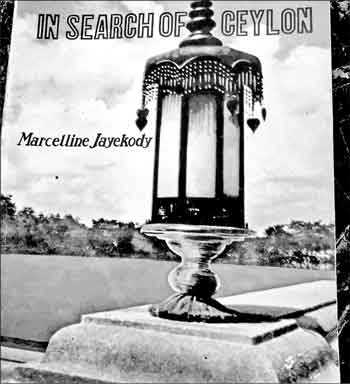Saturday Apr 27, 2024
Saturday Apr 27, 2024
Saturday, 4 January 2020 00:02 - - {{hitsCtrl.values.hits}}
 Glancing through ‘In Search of Ceylon’ (1964) by Father Marcelline Jayekody O.M.I., looking for the lyrics of the song ‘Namo Mariyani’ thinking they were written by him, I found myself virtually being taken through the entire country. In 17 chapters he takes the reader from Jaffna to Hambantota written in the most readable fashion.
Glancing through ‘In Search of Ceylon’ (1964) by Father Marcelline Jayekody O.M.I., looking for the lyrics of the song ‘Namo Mariyani’ thinking they were written by him, I found myself virtually being taken through the entire country. In 17 chapters he takes the reader from Jaffna to Hambantota written in the most readable fashion.
 He starts the first chapter – ‘On for the Road’ thus:
He starts the first chapter – ‘On for the Road’ thus:
“The plane dived low.
I saw a blue fringe of water round Cape Comorin.
My eyes were blurred for a moment and my cheeks were wet.
A little blue flame shot up from the centre of my heart and I felt like a lit candle.
It all happened with the twinkling of an eye. I drew the back of my hand across my eyes and looked through the little glass window. Three Palmyra trees stood against the sky. Golgotha?...”
Father Jayekody flies to Jaffna in an Air Ceylon Dakota from where he begins to narrate the journey.
Writing about ‘Jaffna round the Clock’, he describes the scene at Pooja time at 5 a.m.
I listen to the cathedral bells and look at the eastern sky from my window. I see a colour drama. I see the Sigiri frescoes coming into life. Golden maidens carrying bouquets of golden lotus in thin golden hands for the morning Pooja The nimble, dark toddy tapper with the tools of his trade hung round his waist like some eerie ornament of a head-hunter goes up the palmyra tree with the greasy easy of a canoe slipping
over water
“I listen to the cathedral bells and look at the eastern sky from my window. I see a colour drama. I see the Sigiri frescoes coming into life. Golden maidens carrying bouquets of golden lotus in thin golden hands for the morning Pooja. Long-stemmed buds held between thin long thumbs and forefingers; trays of blown buds held ear-high, breast-high, waist-high. My imagination limns them against the orange-fringed yellow. Eyes of olu buds, hands of olu stems, lips of olu petals, flowers carrying flowers for the ceremonial morning Pooja. The drama goes on – gold, rose, orange, blue…. And suddenly the colours change into pale yellow. The rest of the sky’s cup is blue. The sun then comes up lighting the palm-heads. This is roughly 6 a.m. in Jaffna.”
 He sees “the nimble, dark toddy tapper with the tools of his trade hung round his waist like some eerie ornament of a head-hunter goes up the palmyra tree with the greasy easy of a canoe slipping over water – who can help watching him with big-lipped surprise, as he reaches the tree top, ties himself into position and stands freely to perform the morning ritual of gathering toddy from the little pots hanging from the flower-sheaths? We know it is any time between six and seven in the morning.
He sees “the nimble, dark toddy tapper with the tools of his trade hung round his waist like some eerie ornament of a head-hunter goes up the palmyra tree with the greasy easy of a canoe slipping over water – who can help watching him with big-lipped surprise, as he reaches the tree top, ties himself into position and stands freely to perform the morning ritual of gathering toddy from the little pots hanging from the flower-sheaths? We know it is any time between six and seven in the morning.
“It is February, a blue mist covers him covers him and he looks like a phantom moving in mid-air.”
Passing through Anuradhapura he writes: “What if the kings lived still riding on elephants through this city? The answer must come from the Diary of Destiny. I am looking at Anuradhapura only as a wayfarer and while questions stand in a ring round my head, I pass before the unique Bo tree, between which and me lie two thousand odd years. As I keep on looking, my vision catches the glimpse of a fair princess, Sanghamitta, coming slowly through the mist of Time bringing the destiny of Ceylon on her uplifted hand. In her life was the life and shape of Anuradhapura.
“When I see this ancient tree, I see the whole of Anuradhapura as well as every Buddhist temple and shrine in the island.”
Father Jayekody takes the reader through Polonnaruwa and Sigiriya, to the green hills via the ‘Coils of Lanka’s Shore’ to ‘A hut in the orange grove’ which will be discussed next.
Note: Incidentally, the lyrics of ‘Namo Mariyani’ were written by Kalidasa Kurukulasuriya.
I am looking at Anuradhapura only as a wayfarer and while questions stand in a ring round my head, I pass before the unique Bo tree, between which and me lie two thousand odd years… When I see this ancient tree, I see the whole of Anuradhapura as well as every Buddhist temple and shrine in the island